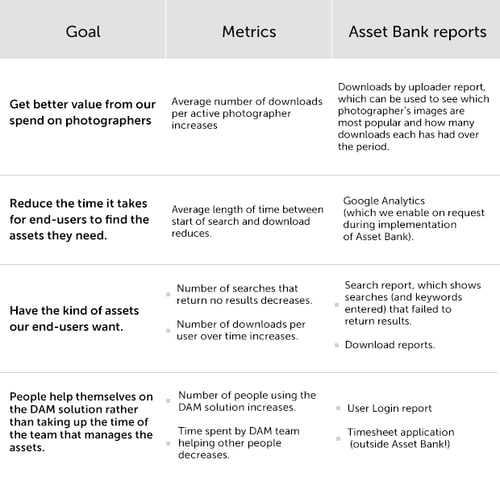
Are you making this mistake with your DAM metrics?

There's a major mistake that people make with metrics — they conflate them with their goals. In most cases, that's a bad idea.
Essentially, organisations like using metrics as they make it simpler to set targets. The downside is that it’s then easy for people to concentrate on the target (“sell 100 new licences”) rather than the real goal (“create profitable and sustainable relationships with 100 new clients”). When staff bonuses are tied to statistics it gets worse, as people are incentivised to concentrate on just one or two elements of the work (the ones being measured), neglecting other activities that might make the real goal more successful.
Another common mistake is using absolute numbers for metrics. These are usually arbitrary (how can they not be?) and penalise desirable outcomes that cannot easily be measured using a spreadsheet, such as teamwork and other human characteristics.
And when it comes to DAM systems, metrics are often underused or just not used properly. So what’s the right way to measure them? In his article on the better use of metrics, Martin Fowler suggests the following guidelines:
- Explicitly link metrics to goals — that way, everyone understands and wants to achieve the true goal, rather than just trying to reach a number.
- Favour tracking trends over absolute numbers — this will make it easier for you to see the impact your changes have over time.
- Use shorter tracking periods — this gives you more opportunity to react and adapt, and to reduce the cost of failed experiments.
- Change metrics when they stop driving change — using metrics properly is time-consuming, so drop metrics that are no longer relevant and instead spend that time working on your real goals.
Where do DAM applications come in?
Now that I’ve convinced you to like metrics again, you’ll be looking for ways to measure the impact of your goal-related experiments. As an example, let’s look at how you might do this for your digital asset management processes, using Asset Bank to help with the metrics.
In the table below I’ve listed some:
i) Example goals.
ii) Possible metrics to measure the effect of your activities.
iii) Reports in Asset Bank that can provide data for the metrics.

(You’ll notice I haven’t included examples of the activities you might try to achieve these goals. In accordance with leadership best-practice, this is best left to the relevant team. No one likes a micro-manager!).
By using your DAM’s metrics intelligently, you'll hopefully gain new insights that can be integrated with your wider aims. Just remember that goals are so much more than just a numbers game.
You might also like: Top 10 metadata attributes for you DAM.

